JIS L 1041 Formaldehyde Testing in Japanese Textiles
The JIS L 1041 standard is a crucial regulation that stipulates methods for determining the formaldehyde content in textiles. This testing protocol ensures that textiles, particularly those intended for direct contact with the skin, do not release excessive levels of formaldehyde which can cause irritation and health risks to consumers.
Formaldehyde, while widely used as a preservative and antifungal agent during manufacturing processes, must be regulated due to its potential to cause adverse effects on human health. The JIS L 1041 method measures the free formaldehyde present in textiles using gravimetric analysis or titration methods.
The testing process involves several critical steps: first, the sample preparation which includes washing and drying the textile according to specified conditions. Then, the actual measurement of the formaldehyde content is carried out using either the titrimetric method or the potentiometric method. These methods are chosen based on the expected concentration levels.
Accuracy in this testing process is paramount; therefore, quality assurance measures include regular calibration checks and proficiency testing. The results must be reported in parts per million (ppm), ensuring compliance with JIS L 1041 standards which specify that textiles for direct skin contact should not contain more than 75 ppm of free formaldehyde.
The importance of this test cannot be overstated, especially given the increasing awareness about chemical safety and consumer protection. Compliance with such regulations is not only a legal requirement but also a responsibility towards public health and well-being.
| Test Parameter | Description |
|---|---|
| Sample Preparation | Washing and drying the textile under specified conditions to remove any surface contamination. |
| Measurement Method | Titrimetric or potentiometric methods for quantifying free formaldehyde content. |
| Reporting Criteria | Results expressed in parts per million (ppm). |
| Acceptance Criteria | Description |
|---|---|
| For Direct Skin Contact Textiles | No more than 75 ppm of free formaldehyde is allowed. |
| Other Textile Types | Specific limits as outlined in JIS L 1041 depending on the type and use of textile. |
The application of this standard extends beyond mere compliance; it plays a vital role in safeguarding consumer health by ensuring products meet stringent quality standards. By adhering to these regulations, manufacturers can build trust with customers who prioritize safety above all else.
- Ensures high-quality textiles free from harmful chemicals.
- Promotes brand reputation through consistent adherence to industry best practices.
- Meets legal requirements imposed by various jurisdictions worldwide.
Industry Applications
The JIS L 1041 formaldehyde testing method finds extensive applications across several industries, primarily focusing on the textile sector. This includes manufacturers of clothing, bedding materials, and other personal care products that come into direct contact with human skin.
| Industry | Application Details |
|---|---|
| Clothing Manufacturing | Testing garments to ensure they meet formaldehyde emission limits for consumer safety. |
| Bedding and Linen Supplies | Evaluating sheets, pillowcases, and towels used in bedding sets. |
| Promotional Products | Surety that promotional giveaways do not pose health hazards to recipients. |
Besides these sectors, the protocol is also applicable within research laboratories conducting studies related to textile chemistry and toxicology. This ensures that all textiles used in such experiments comply with safety standards before being subjected to further analysis or experimentation.
Quality and Reliability Assurance
- Regular calibration of equipment using certified reference materials.
- Incorporation of proficiency testing programs to validate test results.
- Continuous training for laboratory personnel on latest methodologies and best practices.
- Use of advanced analytical instruments such as gas chromatography for precise measurements.
These measures ensure that the testing process remains reliable and accurate, adhering strictly to JIS L 1041 specifications. Regular audits and quality checks further reinforce this commitment to excellence in every aspect of textile production.





